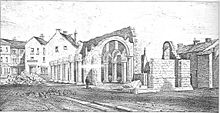Doncaster Market

Doncaster Market lies in the centre of the town of Doncaster, in South Yorkshire, England.
History[]
The market was first chartered in 1248, and was held in and around the church of St Mary Magdalene.[1] It expanded to cover a triangular square, north of the church, on the edge of the then-built-up area.[2] The church was deconsecrated in 1548, and buildings gradually encroached on its churchyard. In 1756, a Butchers' Shambles and butter cross were constructed to the west of the former church, followed in 1778 by a New Shambles.[3]

In the 1780s, cattle sales in the market were gathered together, in Parsonage Row. The market was paved, and it was one of the largest in the country for the sale of wool. In 1843, a corn market was opened, although this was later sold and was re-erected in Goole in 1875. In 1900, an underground cold store and public weighbridge were added to the market, and in 1908, the cattle market was extended, with an octagonal auction ring added.[4]
In 1971, a plan proposed the relocation of the market, but this was not carried out. Instead, in 1974, the marketplace was made a conservation area in 1974. The conservation area includes the variety of two- and three-storey buildings surrounding the marketplace, including 18th- and 19th-century coaching inns, and 20th-century shops. By 2007, the northern end of the marketplace was used as a car park. At the time, Doncaster Metropolitan Borough Council stated that "the market offers a wide range of goods, lively atmosphere and still draws the community into the market place. This is despite a local perception that the market is in decline". At the time, the main market days were Tuesday, Friday and Saturday.[4]
Market Hall, Corn Exchange and Fish Market[]

In 1845, most of the market buildings were demolished, including the former church. A new market hall was constructed in the middle of the cleared area. The new building was designed by J. Butterfield, and was two storeys high, with a U-shaped plan. In 1871, more buildings were cleared, to permit the construction of a corn exchange to infill the "U", and project to the front. This extension was designed by William Watkins and is five bays wide, with red sandstone columns, and a large lunette window. The interior of this section is described by Historic England as "very elaborate", with the upper storey being a three-sided gallery.[3][5] It was principally used for the trading of corn, but also for concerts. After World War II, it became a municipal restaurant and dance hall, then in 1967 it became part of the market.[4]

In 1930, a single storey fish market was added to the rear of the original market hall. The building was grade II* listed in 1950.[5] In 1994, there was a major fire in the Corn Exchange, following which it was restored.[1] The restoration revealed the Mediaeval cemetery and some Roman pottery. The floor of the market hall was raised, and it reopened in 1997.[4]
Wool Market[]

J. Butterfield also designed a woollen market, on the north-east side of the marketplace. It is a 9-by-7 bay hall, constructed of brick and iron, with stalls arranged in four arcades. It was completed in 1863, and renovated in the 20th-century with replacement doors and glazing.[6] It was restored in 2019, to house both stalls selling goods, and food stalls. During renovations, a Mediaeval well was discovered under the floor, which is now visible under glass.[7]
References[]
- ^ a b Chrystal, Paul (2019). Doncaster at Work. Amberley Publishing. ISBN 9781445685922.
- ^ Daunton, Martin J. (2000). The Cambridge Urban History of Britain. Cambridge: Cambridge University Press. ISBN 9780521444613.
- ^ a b "Corn Exchange - Doncaster History". ARCUS. Retrieved 8 December 2021.
- ^ a b c d "Doncaster Market Place: Conservation Area Appraisal and Management Proposals" (PDF). Doncaster Metropolitan Borough Council. Retrieved 8 December 2021.
- ^ a b "THE MARKET HALL, CORN EXCHANGE AND FISH MARKET, MARKET PLACE". Historic England. Retrieved 8 December 2021.
- ^ "FORMER WOOLLEN MARKET HALL TO NORTH OF THE MAGDALEN HOTEL, MARKET PLACE". Historic England. Retrieved 8 December 2021.
- ^ "The Wool Market". Doncaster Council. Retrieved 8 December 2021.
External links[]
- Doncaster
- Retail markets in England
- 1248 establishments in England